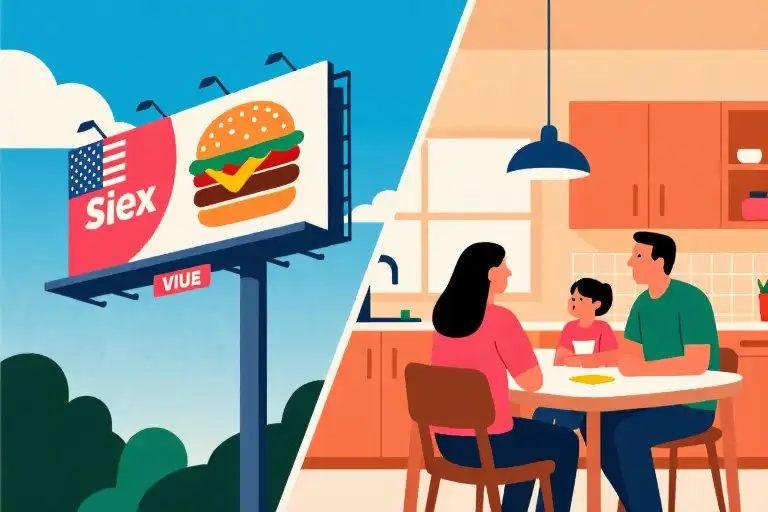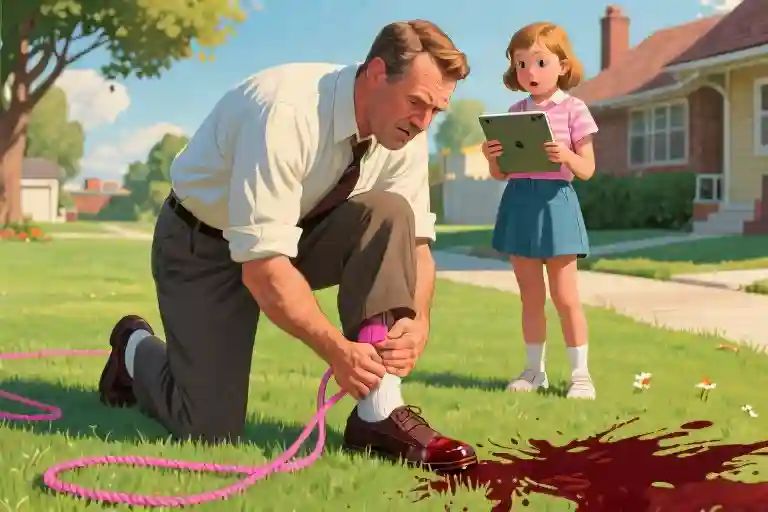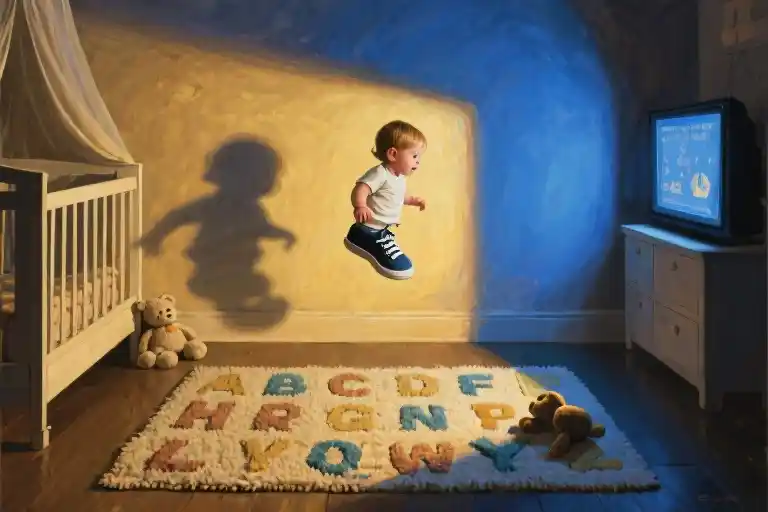In America, we’ve perfected the art of selling hamburgers with bikini-clad models, yet freeze like deer in headlights when our twelve-year-old asks where babies come from. Our billboards scream sex appeal, but our kitchen tables fall silent at the first mention of puberty. This cultural whiplash hit me square in the parenting gut when my teenage son once tried dodging yard work with a creative excuse: “Can’t help with the branches, Dad. I’ve got sex ed homework.
That moment crystallized our national paradox – we commodify sexuality relentlessly in advertising ($500 billion spent annually on sex-driven marketing according to Forbes), yet treat age-appropriate sex education like some radioactive topic. The same society that airs Super Bowl ads with gyrating dancers can’t muster the courage to explain menstruation to middle schoolers without turning fifty shades of red.
What makes this cognitive dissonance particularly jarring is witnessing alternative approaches during my years living in Amsterdam. Dutch parents discuss anatomy with preschoolers as casually as Americans talk about soccer practice. Their comprehensive sex education system – starting at age four according to government guidelines – yields tangible results: teen pregnancy rates 5x lower than the US (WHO data) and 90% of Dutch adolescents reporting positive first sexual experiences (Rutgers Institute study).
This introduction isn’t about shaming American parents – I’ve fumbled through plenty of awkward conversations myself. It’s about recognizing that our discomfort serves nobody, least of all our kids. When my son attempted that homework excuse, it sparked our most productive backyard conversation about consent and responsibility. Those brush piles became our unlikely classroom, proving even mundane moments can transform into natural sex education opportunities when we move past the awkwardness.
The question isn’t whether to teach kids about sex – the data shows they’ll seek information elsewhere if we don’t (75% of teens learn from porn according to a JAMA Pediatrics meta-analysis). The real issue is whether we’ll let commercial interests define sexuality for them, or step up to guide these conversations with the nuance and care they deserve.
Why Americans Use Sex to Sell Burgers But Fear Teaching Kids About It
Walk past any American billboard or flip through a magazine, and you’ll see sex everywhere—lingering on car hoods, dripping from beer bottles, even tucked between burger buns. Yet mention teaching comprehensive sex education in schools, and suddenly the room gets quieter than a library during finals week.
The Data Behind Our Discomfort
According to CDC reports, only 38% of U.S. high schools teach all 19 critical sexual health topics recommended by national health experts. Meanwhile, the U.S. maintains the highest teen pregnancy rate among developed nations—three times that of the Netherlands, where sex education begins at age four. This discrepancy isn’t accidental; it’s cultural whiplash. We’ve created a society where:
- Super Bowl ads feature near-nude models selling pickup trucks (“Built tough!”)
- Parents panic when a kindergarten book mentions different family structures
- 72% of teens report learning about sex primarily from peers or pornography (Guttmacher Institute)
Capitalism’s Double Standard
Here’s the uncomfortable truth: In America, sex sells—unless it educates. Ad agencies spend billions weaponizing sexuality to move product, but the moment we try applying that same openness to children’s health, suddenly everyone’s clutching pearls. Psychologist Dr. Laura Berman calls this “the commercialization-prudishness paradox”:
“We’ve divorced sex from humanity in advertising, making it a tool rather than a natural part of life. When confronted with real conversations about bodies and relationships, many Americans revert to Puritan-era discomfort.”
The Shame Cycle
This cultural schizophrenia starts at home. A 2022 UCLA study found:
- 65% of parents recall receiving zero “birds and bees” talk from their own caregivers
- Those who did often heard vague metaphors (“special hugs”) or warnings (“you’ll ruin your life!”)
- Now, 58% admit repeating the same avoidance patterns with their kids
Sex therapist Dr. Chris Donaghue explains: “When generations are raised treating sex as either a dirty secret or a sales tactic, we lose the vocabulary for normal, healthy discussions.”
Breaking the Silence
The irony? Research shows kids who receive early, factual sex ed at home:
- Delay sexual activity by an average of 1.5 years
- Are 60% more likely to use protection when they do become active
- Report higher confidence setting body boundaries (Journal of Adolescent Health)
Yet at dinner tables across America, we’re still whispering about “private parts” like they’re nuclear codes. Maybe it’s time we treated sex education with the same casual confidence we reserve for selling cheeseburgers.
What Dutch Kids Learn About Sex at Age 4 (And Why It Works)
While American parents often stumble through “The Talk” when their kids hit puberty, Dutch children are having age-appropriate conversations about bodies and relationships from their preschool years. This systematic approach to sex education at home and school yields remarkable results: Dutch teens report first sexual experiences nearly a year later than American peers, with significantly higher contraceptive use and lower STI rates. Here’s what makes their model so effective.
Pillar 1: Early Education Through Play
In Dutch kindergarten classrooms, you’ll find picture books like “Where Did I Come From?” sitting alongside fairy tales. Teachers use simple metaphors (“Your body is like a house – some rooms are just for you”) to teach body autonomy to 4-year-olds. Key lessons include:
- Naming all body parts (using clinical terms like penis/vulva)
- Understanding “underwear areas” as private zones
- Practicing consent through play (“Can I give you a hug?”)
“We normalize these conversations before they become loaded with embarrassment,” explains Amsterdam educator Marja van der Horst. “By age 7, kids can explain basic reproduction like they’d describe how plants grow.”
Pillar 2: Family Participation
Every Dutch parent receives a government-issued parenting guide for sex ed with scripts for real-life moments:
| Situation | Suggested Response |
|---|---|
| Toddler touches genitals | “That’s your private part. We touch it only in private.” |
| Child sees pregnancy news | “Babies grow in a special place called a uterus. Want to see your baby photos?” |
| Teen watches romantic movie | “What do you think makes a healthy relationship?” |
The goal isn’t one big talk, but hundreds of small teachable moments – during bath time, while watching TV, or when younger siblings are born.
The Proof: By the Numbers
Comparative data tells a compelling story:
- Teen pregnancy rates: 5.3 per 1,000 in Netherlands vs. 17.4 in US (Guttmacher Institute)
- Condom use at first sex: 80% (NL) vs. 54% (US) (WHO)
- Average age of first intercourse: 17.1 (NL) vs. 16.2 (US) (Journal of Adolescent Health)
Rotterdam pediatrician Dr. Elsemieke van Driel notes: “When kids grow up seeing sex as a normal part of human development – not something secret or dangerous – they make safer, more informed choices.”
Bringing It Home: Dutch Lessons for American Families
You don’t need to move to Amsterdam to adopt this approach. Start with these Dutch-inspired steps:
- Preschool years: Read body-positive books like Your Whole Body together
- Elementary age: Use household moments (“The dog is pregnant – let’s discuss how that happens”)
- Teens: Frame conversations around values (“In our family, we believe relationships should…”)
As my Dutch neighbor once joked while our kids played: “We teach them to say ‘potty’ and ‘penis’ in the same breath. Why make one word scarier than the other?” It’s this matter-of-fact attitude – not any magic curriculum – that makes the real difference.
The Sex Ed Playbook: From “Where Do Babies Come From?” to Real-World Talks
Parenting rarely goes according to script, especially when it comes to sex education. That moment when your wide-eyed preschooler asks about childbirth during grocery shopping, or when your teenager casually mentions a friend’s relationship drama while loading the dishwasher – these unplanned moments often become the most meaningful teaching opportunities. Here’s how to turn everyday interactions into natural sex education conversations at every age.
Early Childhood (2-5 Years): Planting the First Seeds
“Mommy, how did I get in your tummy?” The checkout line freezes as all ears tune to your response. This is where the Dutch approach shines – they answer simply and matter-of-factly. Try the “seed and soil” analogy that works beautifully for this age group:
“Just like plants need a seed from the daddy plant and soil from the mommy plant to grow, human babies start when a tiny seed (sperm) from dad joins an egg in mom’s body. The baby grows in a special place called the uterus – not the stomach where food goes!”
Key principles for this stage:
- Use proper anatomical terms (penis, vagina, uterus)
- Keep explanations biological rather than emotional
- Normalize these conversations – don’t shush them in public
Elementary Years (6-12 Years): Building Boundaries
This is the golden window for teaching bodily autonomy using what Dutch educators call the “swimsuit rule”:
“The areas your swimsuit covers are private – no one should touch or look at them without a good health reason, and you shouldn’t touch others there either. Even doctors should explain why they need to examine private areas.”
Practical ways to reinforce this:
- During bath time: “Your body belongs to you – even if grandma wants hugs, you can say no.”
- Watching TV: “Notice how that commercial shows people touching without asking? What should they do differently?”
Teen Years (13+): Real-World Readiness
Remember my son’s creative “studying sex ed” excuse to avoid yardwork? That became our most productive conversation yet. As we hauled branches, we discussed:
- Consent through pizza analogies: “If someone says ‘no pepperoni,’ you don’t force it – same with physical contact.”
- Safety practically: “Condoms are like work gloves – the right size matters. Let’s compare brands.”
- Emotional health: “Sex should feel like teamwork, not a performance review.”
Everyday Teaching Moments
The Dutch model proves sex education happens best in life’s in-between moments:
- During chores: Folding laundry? Discuss how bodies change during puberty.
- Commercial breaks: Use ads to critique media portrayals of relationships.
- Car rides: The lack of eye contact makes tough questions easier.
- Cooking together: Compare recipe following to relationship boundaries.
Sample Dialogue: The “Birds and Bees” Remix
Child (8): “Jason said babies come from kissing!”
Parent: “What do you think?” (First, assess their understanding)
“Actually, kissing feels nice but can’t make babies. Remember our plant analogy? Human reproduction needs…”
Teen (15): “All my friends are hooking up.”
Parent: “Let’s unpack that – are we talking hand-holding or more? Either way, what matters is…”
This staged approach transforms awkward lectures into ongoing dialogue. One Dutch study found children receiving gradual, home-based sex ed waited longer to become sexually active and were 50% more likely to use protection. The branches we piled that day? They became kindling for the most productive sex ed lesson we ever had.
Your At-Home Sex Education Starter Kit
After a decade of practicing progressive sex education with my kids—from awkward ‘birds and bees’ talks to casual conversations about consent while stacking firewood—I’ve distilled everything into this actionable checklist. No theoretical fluff, just what works in real family life.
Step 1: Grab Your Age-Approadpriate Roadmap
- Downloadable Guide: Get our free Family Sex Ed Milestones Chart, adapted from Dutch school curricula. It breaks down topics by developmental stage:
- Ages 2-5: Body part names, “good touch/bad touch”
- Ages 6-12: Puberty changes, online safety
- Teens: Contraception, healthy relationships
- Pro Tip: Tape it inside a kitchen cabinet for quick reference during those unexpected “Mom, what’s a condom?” moments.
Step 2: Turn Dinner Table Chat Into Teachable Moments
Instead of formal “talks,” try these organic conversation starters:
- For young kids:
“Remember how we wash hands to stay healthy? Private parts need care too—want to learn how?” - For tweens:
“That TV character lied to their partner. How would you handle honesty in relationships?” - For teens:
“Some states are changing abortion laws. What questions do you have about reproductive rights?”
(Keyword integration: sex education at home, how to talk to kids about sex)
Step 3: Leverage Pop Culture
- When a celebrity pregnancy trend surfaces:
“Notice how magazines focus on women’s bellies? Let’s discuss pregnancy realities.” - During sex scenes in movies:
“Real intimacy isn’t scripted. Want to know what consent actually looks like?”
Step 4: Normalize Through Daily Routines
- Laundry time = Teach bodily autonomy:
“Just like we respect clean/dirty clothes piles, we respect people’s ‘no.'” - Grocery shopping = Discuss media literacy:
“See how this perfume ad uses sexuality? Let’s analyze its message.”
My 10-Year Verification
That son who once used “studying sex ed” to dodge chores? At 17, he now:
- Confidently discusses STI prevention with partners
- Corrects peers’ toxic masculinity comments
- Still laughs about “the great brush pile evasion”—proof these conversations build trust without losing humor
(Long-tail keyword: parenting tips for teens)
Tonight’s Homework (Yes, Really)
- Bookmark [Amaze.org] (Dutch-style animated videos)
- At dinner, ask ONE open-ended question from our list
- High-five yourself—you’ve begun dismantling generations of awkwardness
“Sex sells burgers because we let it. Let’s make it sell healthy relationships too.”
The Journey from Awkward Branches to Open Conversations
That same son who once tried to dodge yard work with a last-minute “sex ed” excuse now casually discusses contraceptive brands while hauling branches. Our journey mirrors what Dutch families have long understood: when sexuality is normalized through everyday dialogue, it loses its power to embarrass or divide.
When Sex Sells Burgers But Silences Families
American culture remains trapped in paradox. We plaster hypersexualized images across billboards to sell fast food, yet blush when our teens ask basic anatomy questions. Commercial interests have co-opted sexuality as a marketing tool while families struggle with authenticity. The breakthrough came when we stopped treating sex education as a single “talk” and started viewing it as an ongoing conversation woven into ordinary moments – exactly like those Dutch parents featured in international studies.
Small Starts, Big Impacts
Begin with manageable steps:
- Leverage pop culture: When a TV show depicts relationships, ask “What do you think about how they handled that situation?”
- Create dialogue rituals: Designate car rides or dishwashing time for open-ended questions
- Normalize terminology: Use clinical terms for body parts during bath time or doctor visits
- Model consent culture: “May I hug you?” teaches more than any lecture
Your Turn to Break the Silence
That first conversation might happen:
- During a commercial break when dating scenes appear
- While folding laundry and discussing body autonomy
- Baking cookies and explaining how ingredients combine (a sneaky metaphor for reproduction)
Remember: perfection isn’t required. My early attempts involved stammering through plant pollination analogies. What matters is creating space for questions without judgment. After all, if we can use sex to sell hamburgers, shouldn’t we use it to build healthier families?
Final thought: What everyday moment will you transform into your first open dialogue?





